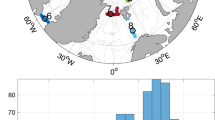Abstract
This study analyzed the current meter records along with wind records for over 500 days obtained in the Kangjin Bay, South Sea, Korea spanning from March, 2003 to Nov. 2005. Various analyses include descriptive statistics, harmonic analysis of tidal constituents, spectra and coherence, the principal axis, progressive vector diagrams. These analyses can illustrate the response of residual current to the local wind resulting in the net drift with rotational motion. Current speed ranges from -28 to 33 (cm/sec), with standard deviations from 6.5 to 12.9 (cm/sec). The harmonic analyses of the tidal current show the average form number, 0.12 with semi-diurnal type and the recti-linear orientation of the major axis toward northeast. The magnitudes of the semi-major range from 12.7 to 17.7 (cm/sec) for M2 harmonics, while for S2 harmonics, they range from 6.3 to 10.4 (cm/sec), respectively. In the spectral and coherency analysis of residual current and wind, a periodicity of 13.6 (day) is found to be most important in both records and plays an important role in the net drift of residual current. The progressive vector diagrams of residual current and wind show two types of behaviors such as unidirectional drift and rotational motion. It was also found that 3 % rule holds approximately to drive 1 (cm/sec) drift current by 30 (cm/sec) wind speed based on the correlation of the semimajor axis of wind and residual current.
Similar content being viewed by others
References
Blackman, R.B. and J.W. Tukey. 1958. The Measurement Of Power Spectra from the Point of View of Communication Engineering. Dover Publications. 190 p.
Cai S., Q. Huang, and X. Long. 2003. Three-dimensional numerical model study of the residual current in the South China Sea.Oceanol. Acta,26(5), 597–607.
Chang, S.D., C.K. Kim, and J.S. Lee. 1993. Field observations and hydraulic model experiments of tidal currents in Chinhae Bay.J. Korean Fish. Soc.,26(4), 346–352.
Cho, H.Y., J.W. Chae, and S.Y. Chun. 2002. Stratification and do concentration changes in Chinhae-Masan Bay.J. Korean Soc. Coast. Ocean Eng.,14(4), 295–307.
Cho, K.D., C.I. Cho, B.G. Lee, K.W. Cho, and D.S. Kim. 1993. Study on the water and material exchange in Deukryang Bay I. Volume transport and turnover time of sea water.J. Environ. Sci.,7(3), 311–319.
Duchon, C.E. 1979. Lanczos filtering in one and two dimensions.J. Appl. Met.,18, 1016–1022.
Emery, W.J. and R.E. Thomson. 2001. Data Analysis Methods in Physical Oceanography. Elsevier. 638 p.
Foreman, M.G.G. 1978. Manual for tidal current analysis and prediction. Pacific Marine Science Report 78-6. Institute of Ocean Sciences, Patricia Bay, Victoria, B.C. 39 p.
Foreman, M.G.G., D.J. Stucchi, Y. Zhang, and A.M. Baptista. 2006. Estuarine and tidal currents in the Broughton Archipelago.Atmos. Ocean,44(1), 47–63.
Guo, X. and T. Yanagi. 1996. Seasonal variation of residual current in Tokyo Bay, Japan-diagnostic numerical experiments.J. Oceanogr.,52, 597–616.
Jenkins, G.M. and D.G. Watts. 1968. Spectral Analysis and Its Applications. Holden-Day. 525 p.
Han, M.W., K.I. Chang, and Y.C. Park. 2001. Distribution and hydrodynamic model of the Keumdong oil spill in Kwangyang Bay, Korea.Environ. Int.,26(7-8), 457–463.
Kashiwai, M. 1984. Tidal residual circulation produced by a tidal vortex. Part 1. Life-history of a tidal vortex.J. Oceanogr. Soc. Japan,40(6), 279–294.
Lee, D.I., C.K. Park, and H.S. Cho. 2005. Ecological modeling for water quality management of Kwangyang Bay, Korea.J. Environ. Manage.,74(4), 327–337.
Lee, J.C., J.C. Kim, and M.W. Park. 2006. Currents in the northeastern Gwangyang Bay.J. Korean Soc. Oceanogr.,11(4), 172–178.
Liu, J.T. 1992. The influence of episodic weather events on tidal residual currents: A case study at Sebastian Inlet, Florida.Estuaries,15(2), 109–121.
Marinone, S.G. and M.F. Lavýn. 2005. Tidal current ellipses in a three-dimensional baroclinic numerical model of the Gulf of California.Estuar. Coast. Shelf Sci.,64, 519–530.
Ou, H.W., R.C. Beardsley, D. Meyer, W.C. Boicourt, and B. Butman. 1980. An analysis of subtidal current fluctuations in the Middle Atlantic Bight.J. Phys. Oceanogr.,11(10), 1383- 1392.
Park, K., H.S. Jung, H.S. Kim, and S.M. Ahn. 2005. Threedimensional hydrodynamic-eutrophication model (HEM-3D): Application to Kwang-Yang Bay, Korea.Mar. Environ. Res.,60(2), 171–193.
Pawlowicz, R., B. Beardsley, and S. Lentz. 2002. Classical tidal harmonic analysis including error estimates in MATLAB using T_TIDE.Comput. Geosci.,28, 929–937.
Ro, Y.J., W.S. Jun, K.Y. Jung, and B.H. Kim. 2005. Numerical modeling of river plume in the Kangjin Bay and its implication for the ecosystem. Proc. Autumn Meeting, 2005 Korean Soc. Oceanogr., p. 218–220.
Ro, Y.J. 2006. Internet-based realtime monitoring of the environ m en tal parameters in the marine large-arc shell culture bed and its productivity assessment model. Final Report, Ministry of Marine and Fishery. 155 p.
Ro, Y.J. 2007. 3-D baroclinic numerical modeling of the tidal and density current in the Kangjin Bay, South Sea, Korea, Part I: Tide and tidal current.J. Korean Soc. Coast. Ocean Eng. (In Press)
Yanagi, T. 1983. Generation mechanisms of tidal residual circulation.J. Oceanogr. Soc. Japan,39(4), 156–166.
Yasuda H. 1980. Generating mechanism of the tidal residual current due to the coastal boundary layer.J. Oceanogr. Soc. Japan,35(6), 241–252.
Wang S.Y. and M.X. Tang. 2004. Exact Confidence Interval for Magnitude-Squared Coherence Estimates.IEEE Signal. Proc. Lett.,11(3), 326–329.
Wong, K.C. 1998. The seasonal and subtidal variability in the source region of the Delaware Coastal Current.Estuar. Coast. Shelf Sci., 47, 1–19.
Valle-Levinson, A. and T. Matsuno. 2003. Tidal and subtidal flow along a cross-shelf transect on the East China Sea.J. Oceanogr.,59, 573–584.
Author information
Authors and Affiliations
Corresponding author
Rights and permissions
About this article
Cite this article
Ro, Y.J. Tidal and Sub-tidal Current Characteristics in the Kangjin Bay, South Sea, Korea. Ocean Sci. J. 42, 19–30 (2007). https://doi.org/10.1007/BF03020907
Received:
Revised:
Accepted:
Issue Date:
DOI: https://doi.org/10.1007/BF03020907



